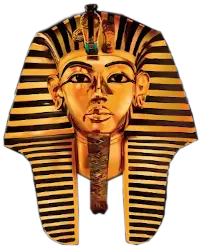
thirty-two feet in height and 21 feet in circumference. On different parts of the columns, and the walls are represented acts of homage by the king to the principal Deities of the Theban Pantheon, and the gracious promises which they make him in return.
In another sculpture the two chief Divinities of Egypt invest him with the emblems of military and civil dominion, i.e., the Scimitar, the Scourge and the Pedum. Beneath, the twenty-three sons of Rameses appear in procession, bearing the emblems of their respective high offices in the state, their names being inscribed above them. Nine smaller apartments, two of them still preserved, and supported by columns, lay behind the hall. On the jambs of the first of these apartments are sculptured Thoth: the Inventor of Letters, and the Goddess Saf, with the title of 'Lady of Letters'; and 'President of the Hall of Books', accompanied the former with an emblem of the sense of sight, and the latter of hearing.
There is no doubt that this is the "Sacred Library" which Diodorus describes as the inscribed "Dispensary of the Mind". It had an astronomical ceiling, in which the twelve Egyptian months are represented, with an inscription from which important inferences have been drawn respecting the chronology of the reign of Rameses III.
On the walls is a procession of priests, carrying the Sacred Arts, and in the next apartment, the last that now remains, the king is presenting offerings to the various Divinities. (Ancient Egypt by J. Kendrick Bk. I p. 128-131. Report of French Commission).
C. Museum and the Library of Alexander were used as a University.
The Museum and Library of Alexandria were so famous in ancient times, that we wonder why more information concerning this centre of learning, has not come down to us. A few references to authoritative sources might no doubt help to enlighten us on this matter.
Topics
Greek Philospohy is Stolen Egyptian Philosophy
The Memphite Theology is the Basis of all Important Doctrines of Greek Philosophy
Greek Philosophy was Alien to the Greeks
Greek Philosophy was the offspring of the Egyptian Mystery System
The Egyptians Educated the Greeks
The Curriculum of the Egyptian Mystery System
The Pre-Socratic Philosophers and the teaching Ascribed to them
The Athenian Philosophers
1. Socrates
2. Plato
3. Aristotle